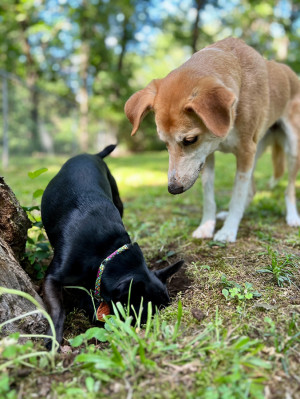Symptoms and Treatments For Urinary Tract Infections (UTIs) in Dogs
If your pup’s bathroom habits have changed, they might have a UTI. Here’s how to help

Share Article
“What’s that wet spot on the floor?” Surely it couldn’t be from your dog, who has been perfectly housebroken since puppyhood. You wipe it up and sniff. That’s unmistakably wee. And is that a little bit of bloodopens in a new tab? Your dog seems fine but certainly does look a bit guilty. Over the next few hours, there are frequent requests to go outside and constant squatting. It seems like a urinary tract infection (UTI), but you’re not sure if that’s even a thing that dogs get. Right?
What is a urinary tract infection (UTI) in dogs?
A UTI is an infection of any type that colonises the urinary system. UTIs can be caused by bacteria, fungi, yeast or even wormy parasitesopens in a new tab. One of them is called the giant kidney worm – don’t look that up unless you have a strong stomach. But bacterial infections are by far the most common, so the focus will be on them.

littleKin™ is Kinship’s home just for puppy and kitten parents. Bop over to check out expert advice, new pet tools, and special deals—all curated for your newest family member.
opens in a new tabThe usual site for infection to occur is the bladder, but UTIs can also involve the kidneys, ureters, urethra or prostate (in male dogs). Dogs with bladder infections usually develop bacterial cystitis, which is inflammation of the bladder wall due to infection. This inflammation is what makes your dog think they need to wee on your rugs every five minutes.
Some dogs can have no symptoms at all but still have bacteria in their urine. These asymptomatic UTIs may or may not need treatment, depending on the dog’s other health conditions. Killing bacteria that are hanging out where they shouldn’t be seems like an obvious solution, but it’s not always right. Overuse of antibiotics can result in health issues or can make future infections more difficult to treat.
What is the cause of UTI in dogs?
Sometimes it’s hard to pinpoint the cause of a UTI. If it’s a one-off event in a dog who seems to be doing well otherwise, an extensive work-up may not even be done. The most common way a UTI develops is an ascending infection, in which bacteria (usually faecal) invade from the outside, through the urethra, and into the bladder.
Tracking down the cause is challenging because several factors can contribute to the development of UTIs in dogs, including:
Poor hygiene
Matted or dirty hair over the genital area can set dogs up for a UTI. Dogs with skin allergies may also lick their genital area frequently, leaving a damp environment that can encourage bacterial growth. A contaminated environment can lead to infection as well. No one wants to lay in old poo, so clean up your dog’s play area regularly.
Female anatomy
Female dogs have shorter urethras than males, making it easier for bacteria to enter the urinary tract. Some female dogs can have a hooded vulva or other anatomical abnormalities that harbour bacteria or trap old urine.
Bladder stones
Dogs can develop cystic calculi, or bladder stones, due to a variety of genetic and dietary factors. These stones can harbour bacteria and lead to chronic or recurrent UTIs until they are removed.
Urine retention
When dogs are unable to fully empty their bladder, urine can stagnate and provide a favourable environment for bacterial growth. Factors contributing to urine retention include urinary tract abnormalities, spinal issues or tumours.
Weakened immune system
A compromised immune system can make dogs more susceptible to infections, including UTIs. Conditions such as diabetes, kidney disease, hyperadrenocorticism, use of certain medications or other underlying health issues can weaken the body’s natural defences.
Catheterisation or urinary procedures
Interventions that involve the insertion of urinary catheters or other instruments into the urinary tract can introduce bacteria and potentially cause infections. The risk of infectionopens in a new tab is always weighed when considering these procedures.
What are the common symptoms of a UTI in dogs?
Dogs with UTIs can show a variety of symptoms, depending on the location of the infection. Dogs with bacterial cystitis, or infection of the urinary bladder, commonly show signs such as:
frequent urination, only producing small amounts
straining to urinate
painful urination
blood in the urine
cloudy or foul-smelling urine
licking the genital area frequently
accidents in the house
If an infection reaches the kidneys (called pyelonephritis), it usually makes dogs feel much sicker. These dogs will show more severe symptoms, such as:
lethargy or weakness
fever
decreased appetite
abdominal pain
How is a UTI diagnosed in dogs?
A urine culture confirms a UTI in dogs. In this test, urine that has been collected using a sterile technique is sent to a lab to see if bacteria will grow. This test is usually combined with a sensitivity test to find out which antibiotics will work to kill those bacteria. While these tests are great and give the best information about diagnosis and treatment, they are slow. Results take three to five days to return, which is a long time to wait if you feel like your bladder is on fire.
Vets will often start with a test called a urinalysis instead. With this test, urine is analysed for trace amounts of blood and other indicators of infection. The urine is also looked at under a microscope – if there are bacteria and white blood cells seen, a UTI is very likely. Depending on the dog’s age and medical history, some blood work to check for kidney issues or diabetes may be recommended as well.
What is the treatment of UTI in dogs?
If the urinalysis shows that a UTI is likely, treatment is often started based on that alone. The urine culture and sensitivity should still be performed to confirm the diagnosis and make sure that the infection is treated appropriately.
Antibiotics are the mainstay of treatment for bacterial urinary tract infections. Your veterinarian will choose an antibiotic based on a number of factors in your dog’s history. Antibiotic courses for bacterial cystitis tend to be very shortopens in a new tab (sometimes just three days), while treatment for a kidney infection can last weeks.
While your dog is recovering from a UTI, it’s important to keep water freely available, make sure that symptoms are resolving quickly and watch for any new symptoms. Most dogs with uncomplicated infections respond well to antibiotics and get back to their normal routine within a day or so. Even if your dog bounces back quickly, it’s important to have their urine rechecked by your vet at the end of the antibiotic course to make sure the infection has cleared.
Can a dog’s UTI be treated with home remedies?
There have been no proven home remedies for treating UTIs in dogs. Bacterial infections can go from uncomfortable to dangerous quickly, so it’s important to get appropriate treatment soon after symptoms are noted.
Are there any preventive measures I can take to reduce the risk of UTIs in my dog?
Some UTIs will happen no matter what you do, so don’t feel guilty if one develops. Some general precautionary measures include the following:
Provide ample fresh water for your dog to encourage adequate hydration.
Take your dog outside regularly for bathroom breaks.
For longer-haired dogs, keep their genital area trimmed or regularly cleaned.
Keep chronic health issues like diabetes under control.
Avoid prolonged urinary retention by ensuring your dog has regular opportunities to relieve themselves.
For dogs with chronic urinary issues or bladder stones, feed a diet that promotes urinary health if recommended by your veterinarian.
UTIs can make dogs go from happy-go-lucky to a mess of wee quickly. While some UTIs can be scary or complicated, most are fixed after some basic diagnostics and a short course of an antibiotic. Once signs show up, getting your dog to the vet for a urinalysis as soon as possible is the best way to get them relief. Both your dog and your rugs will appreciate your hustle.
Frequently asked questions
What are the common symptoms of a UTI in dogs?
UTIs in dogs commonly cause small, frequent urinations, straining or discomfort when urinating, bloody urine and accidents in the house.
Can I visually inspect my dog’s urine to determine if they have a UTI?
While visible urine changes may indicate a UTI, not every dog with a UTI has them and not every dog with abnormal urine has a UTI. Get the urine checked by your vet to be sure.
What should I do if I suspect my dog has a UTI?
If your dog is showing signs of a UTI, take them to the vet. Some simple tests can be done to diagnose a UTI and make sure your dog gets appropriate treatment.
How is a UTI diagnosed in dogs?
UTIs in dogs are first diagnosed with a urinalysis done by your vet. The urine can then be sent to a lab to confirm the UTI and see what antibiotics are best for treatment.
Can a dog’s UTI be treated with home remedies?
There are no proven home remedies for UTIs in dogs. See a vet for appropriate treatment before the UTI progresses to a more serious infection.
Are there any preventive measures I can take to reduce the risk of UTIs in my dog?
Giving your dog frequent opportunities to wee, keeping fresh water available and maintaining good hygiene are the best ways to reduce the risk of UTIs.
Can UTIs be a sign of an underlying health issue in dogs?
UTIs can sometimes be associated with problems like diabetes, kidney disease, Cushing’s disease, immune compromise, bladder stones or other health issues.
What is the cause of UTI in dogs?
UTIs are most commonly caused by faecal bacteria migrating from the outside. These bacteria travel up the urethra and invade the bladder, causing infection and inflammation.
References

Dr. Bartley Harrison, DVM
Dr. Bartley Harrison, DVM is a small animal veterinarian based in North Carolina who has practiced emergency medicine since graduating from the Texas A&M College of Veterinary Medicine. His primary interest areas include pain management, cardiology, and the treatment of shock.
He is a member of the Veterinary Emergency and Critical Care Society, American Veterinary Medical Association, and American Medical Writers Association. In addition to his clinical work, he writes pet health articles to help provide accurate information for both new and experienced pet parents. When he’s not working, he enjoys cooking, traveling, reading, and going on adventures with his dog.
Related articles
![A black dog with a tilted head looks attentively at the camera while sitting in grass.]() opens in a new tab
opens in a new tabIs My Dog’s Poo Normal?
From bloody poo to diarrhoea – all your dog’s poo problems explained
![feeding black dog rice water to help relieve diarrhea]() opens in a new tab
opens in a new tabHow to Treat Your Dog’s Diarrhoea
Shudder. It happens to all of us
![Woman taking care of her sick dog at home.]() opens in a new tab
opens in a new tabCan Dogs Take Aspirin? A Guide to Dog Pain Medication
There are safer alternatives and you should always, always check with a vet before giving your pup anything
![Two dogs digging outside in the dirt.]() opens in a new tab
opens in a new tabTypes of Worms In Dogs: How to Detect and Treat Worms In Dogs
Here are the types of worms your pup could get, how you know they have them in the first place and how to get rid of them for good
![Side view of a cute hungry dog standing next to a red bowl with food in a studio with white background]() opens in a new tab
opens in a new tabHow to Get a Dog to Eat
You can’t appease a picky dog with chicken nuggets like you can with a toddler. Here are some things you can do
![dog near pee spot on carpet]() opens in a new tab
opens in a new tabHow to Remove Dog Wee and Other Stains from Carpet – Without Harsh Chemicals
The next time your dog wees on your favourite rug, be prepared with this simple, three-step cleaning method









